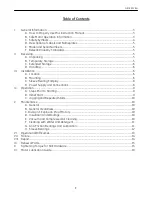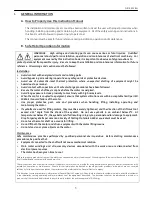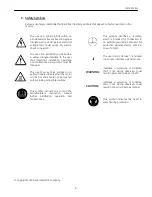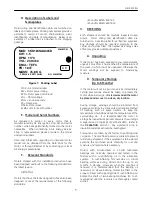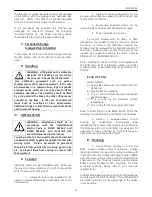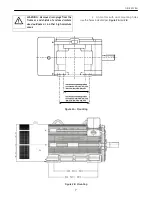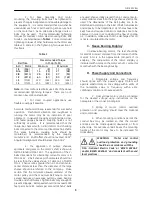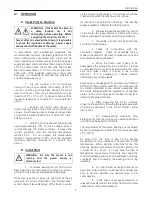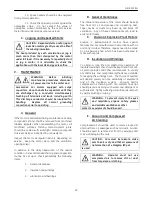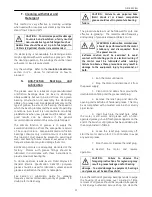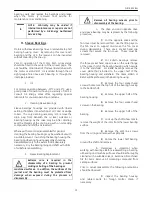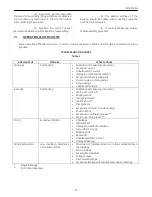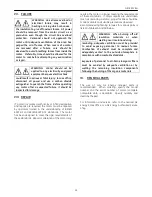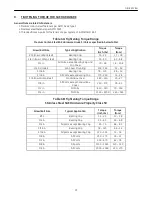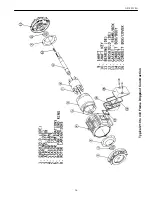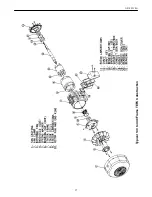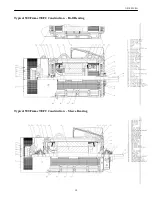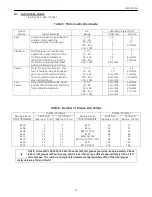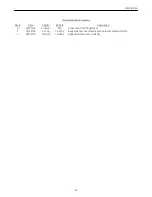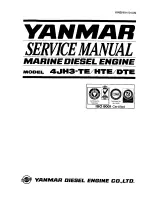
GEI-56128H
9
IV. OPERATION
A. Steps Prior to Starting
WARNING
:
If the motor has been in
a damp location, dry it out
thoroughly before operating. Before
energizing the motor for the first
time or after an extended shut down, it is advisable
to check the insulation resistance, power supply
and mechanical freedom of the motor.
In accordance with established standards, the
recommended minimum insulation resistance for the
stator winding when measured with a 500 volt DC
direct indicating ohmmeter with self-contained power
supply (megger), shall not be less than 5 mega-ohms at
40
°
C for a motor rated under 1000 volts, and not less
than 100 mega-ohms at 40
°
C for a motor rated over
1000 volts. If the insulation resistance is lower than
this value, it is advisable to eliminate the moisture in
one of the following ways.
1. Dry the winding in an air-circulating
oven with the air surrounding the winding at 110
°
C,
+5/-15
°
C until the part has been above 90
°
C for at
least four hours. Then the air temperature may be
raised to 150
°
C, +5
°
C/-15
°
C. Continue to heat until the
insulation resistance is constant for a one-half-hour
period.
2. Enclose the motor with canvas or
similar covering, leave a hole at the top for moisture to
escape. Insert heating units or lamps and leave them
on until the insulation resistance is constant for a one-
half hour period.
3. With the rotor locked mechanically and
using approximately 10% of rated voltage, pass a
current through the stator windings. Increase the
current gradually until the winding temperature
reaches 90
°
C. Do not exceed this temperature.
Maintain a temperature of 90
°
C until the insulation
resistance becomes constant for a one-half hour
period.
B. Initial Start
WARNING:
Be sure the motor is not
running and the power supply is
disconnected.
1. For sleeve-bearing motors, flush out all
sleeve bearings with kerosene to remove any dust or
grit which may have accumulated during storage.
Make sure that the oil plugs are tight and fill the oil
wells with the oil recommended in the “Maintenance”
section under “Sleeve Bearings” of this book to center
of the oil level sight gauges. The oil level should be
checked only when the machine is not running.
Do not flush out anti-friction bearings. The bearing
grease supplied is sufficient for initial operation.
2. Whenever possible, examine the interior
of the motor for loose objects or debris which may
have accumulated and remove any foreign material.
3. If possible, turn the rotor by hand to be
sure that it rotates freely.
4. Check all connections with the
connection diagram. Check all accessible factory
made connections for tightness to make sure none has
become loose during shipment.
5. When the driven load is likely to be
damaged by the wrong direction of rotation, it is best
to uncouple the motor from its load during the initial
start and make certain it rotates in the correct
direction. If it is necessary to change rotation,
interchange any two line leads.
Some motors are designed for unidirectional rotation.
Rotation of these motors must be in accordance with
the rotation indicated on the motor’s nameplate and
the outline furnished with the equipment. Connection
plates on the motor have been furnished to assist in
obtaining the proper rotation.
6. After inspecting the motor carefully,
make the initial start by following the regular sequence
of starting operations in the motor starter control
instructions.
7. For sleeve-bearing machines, after
starting verify that the oil rings are operating properly
and that oil is being fed to the shaft.
The temperature of the sleeve bearings, as measured
by bearing temperature detectors, should not exceed
93
°
C (200
°
F).
At initial start, the rate of rise of the bearing
temperature is more indicative of trouble than is total
temperature. When starting a machine for the first
time, the bearing temperature should be observed for
a minimum of 2 hours. If at any time the rate of
temperature rise exceeds 2
°
C/minute, shut down the
motor immediately and make an investigation of lineup
conditions, and if necessary, the bearing and oil ring
assembly.
8. For anti-friction bearings check motor
operation under load for an initial period of at least one
hour to observe whether any unusual noise or hot
spots develop.
9 In the event of excessive vibration or
unusual noise disconnect the motor from the load and
check the mounting and alignment.


